Fintech
Overcoming the challenges of using a mobile FinTech API

In this digital age, we are constantly seeing innovative solutions to revolutionize the way we interact with money.
African network provider MTN’s Mobile Money platform is at the forefront of this evolution. It allows users to perform various financial transactions using their mobile devices, such as sending and receiving money, paying bills, purchasing airtime and data, and saving or borrowing money.
THE MTN MoMo API allows developers to seamlessly integrate MTN Mobile Money’s many features into applications and systems. From transaction facilitation to enable digital commerceits potential is immense.
Even so, the MTN MoMo API It has its own technical challenges, including security issues related to data breaches and issues with downtime and functionality. Navigating its complexities can be daunting, and there are areas where clarity and functionality could be improved. As a technologist, you can help solve MTN MoMo API issues by contributing to open source, such as projects on GitHub.
In this tutorial we will enhance the MTN MoMo Open API using Postman as our primary API platform, although you can use any client platform you feel comfortable with. In this guide I will conduct tests in the sandbox environment. If you decide to go live, be prepared for a simple and self-explanatory process.
Head to the MTN MoMo Developer platform and set up your account to get things started. When you sign up, you will have access to various products within the MoMo API ecosystem, including collections, disbursements, collection widgets, and remittances, designed to tailor functionality to the needs of your application. Subscribing to these products is essential to obtain the primary and secondary keys necessary for the perfect integration of this service.
Visual representation of the subscribed products.
We are focusing on the collection product, which facilitates remote payment collection from consumers of your service. Although the API endpoints differ, the operational logic remains consistent across all products.
Our first goal is to generate a user and API key for OAuth 2.0 authentication. Every time Ocp-Apim-Subscription-Key is mentioned, it refers to the UUID (Universally Unique Identifier) V4 that we will generate later. Likewise, X-Reference-Id indicates the primary key obtained for the post-product subscription. While it might seem complex, don’t worry. We will go through each step together.
The Collections product offers a range of API endpoints that can improve the functionality of our applications.
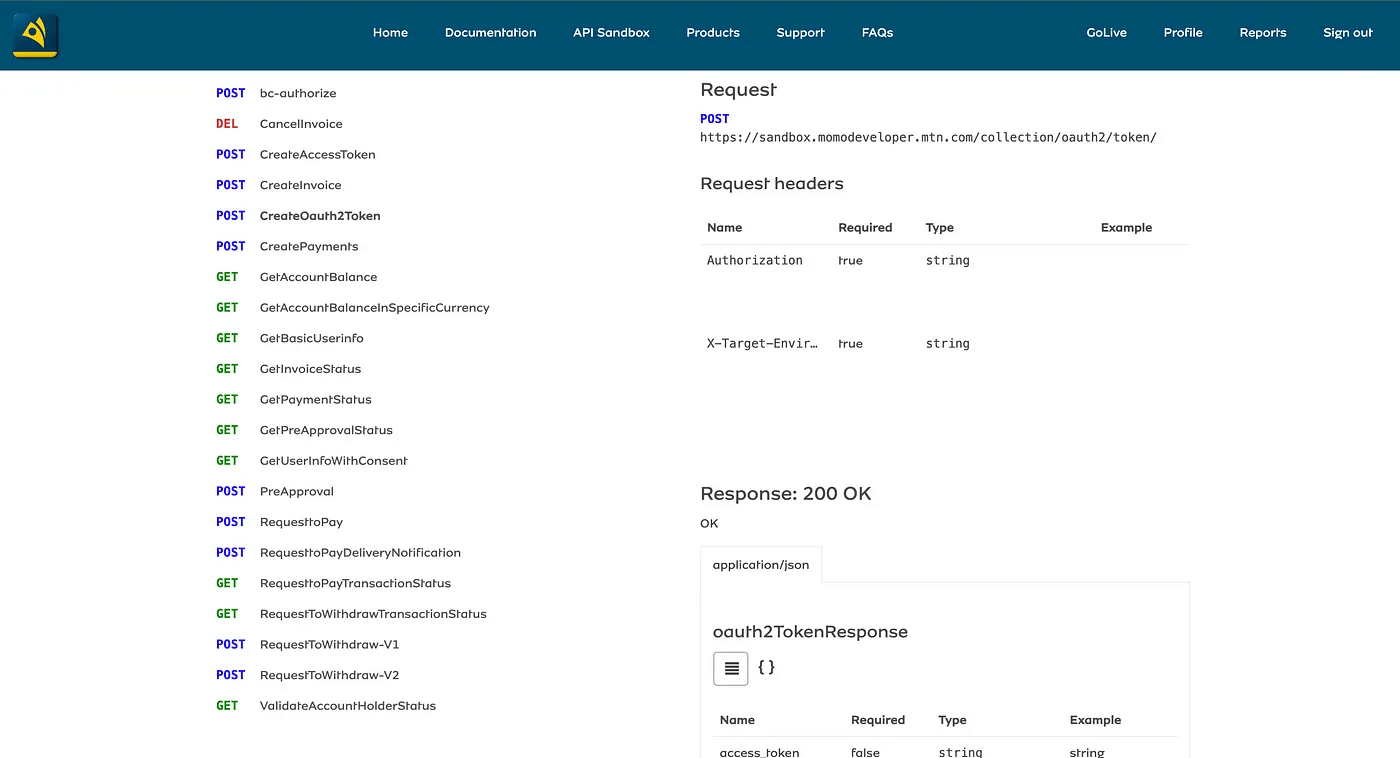
List of endpoints exposed by the collections product.
However, we can’t use them yet without creating an API user, which we’ll do later.
Prepare your favorite API platform, like the postmanand access the URL https://sandbox.momodeveloper.mtn.com/v1_0/apiuser to initiate a POST request. Make sure you include the file X-Reference-Id and the Ocp-Apim-Subscription-Key in the request headers. THE X-Reference-Id corresponds to the V4 UUID that you can generate for free UUID generator website. On the contrary, the Ocp-Apim-Subscription-Key represents the primary key acquired after subscribing to the product. Following the documentation, it is essential to include a callback function in the request body to be executed after the request executes successfully. For demonstration purposes we will use a generic callback function. If necessary, you can get your own custom callback feature from a free and accessible site callback function generator.
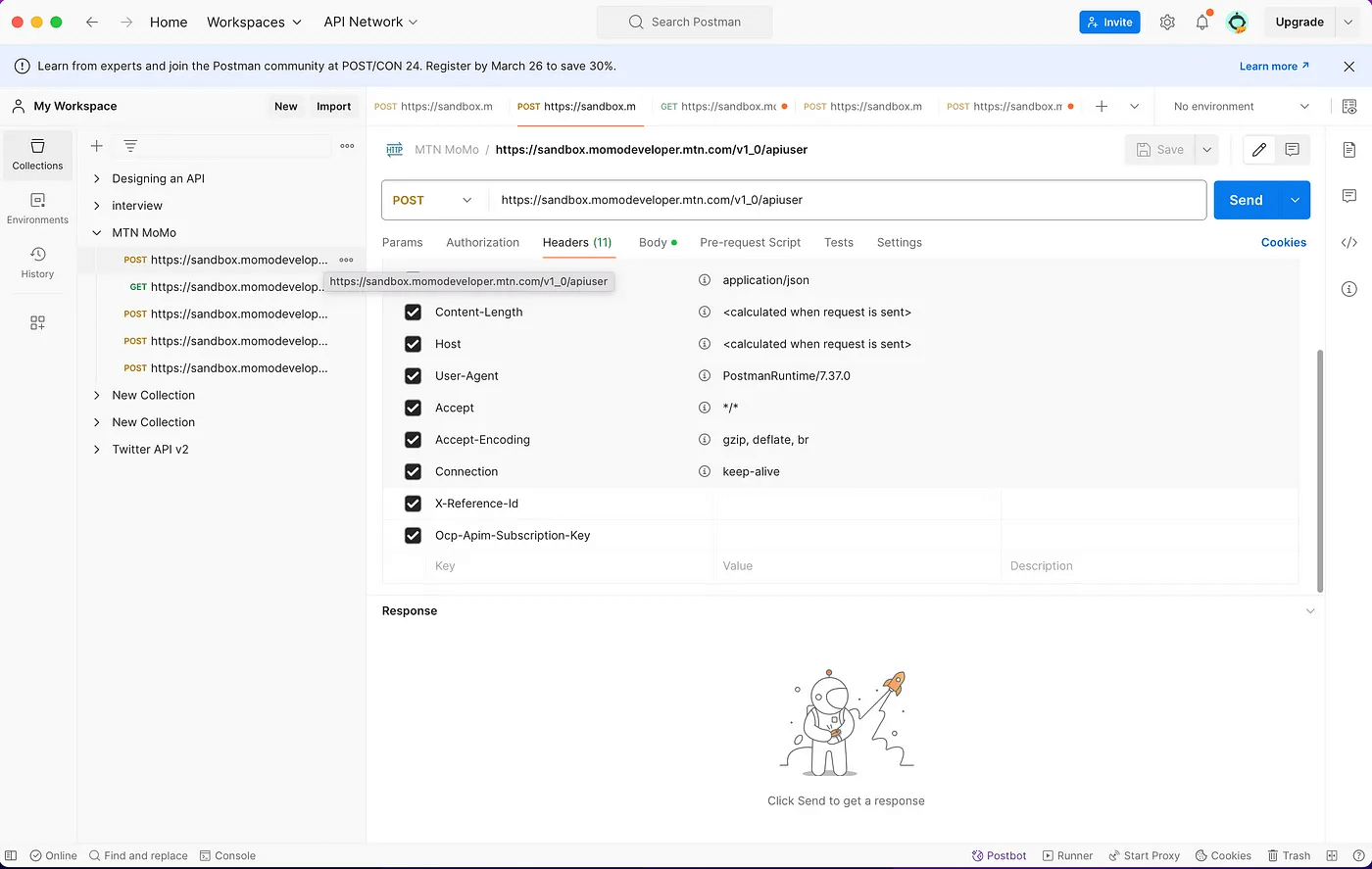
Visual representation of the headers to include in the API user creation request. (Mine are hidden)
After submitting the request, a status code created by resource 201 will confirm that an API user was created. However, you may notice that the response body is missing user information that is essential for subsequent requests. To acquire this critical data, perform a GET request to the URL https://sandbox.momodeveloper.mtn.com/v1_0/apiuser/{X-Reference-Id}, replacing “X-Reference-Id” with the UUID from user creation. Remember to include the Ocp-Apim-Subscription-Key in the headers for authentication.
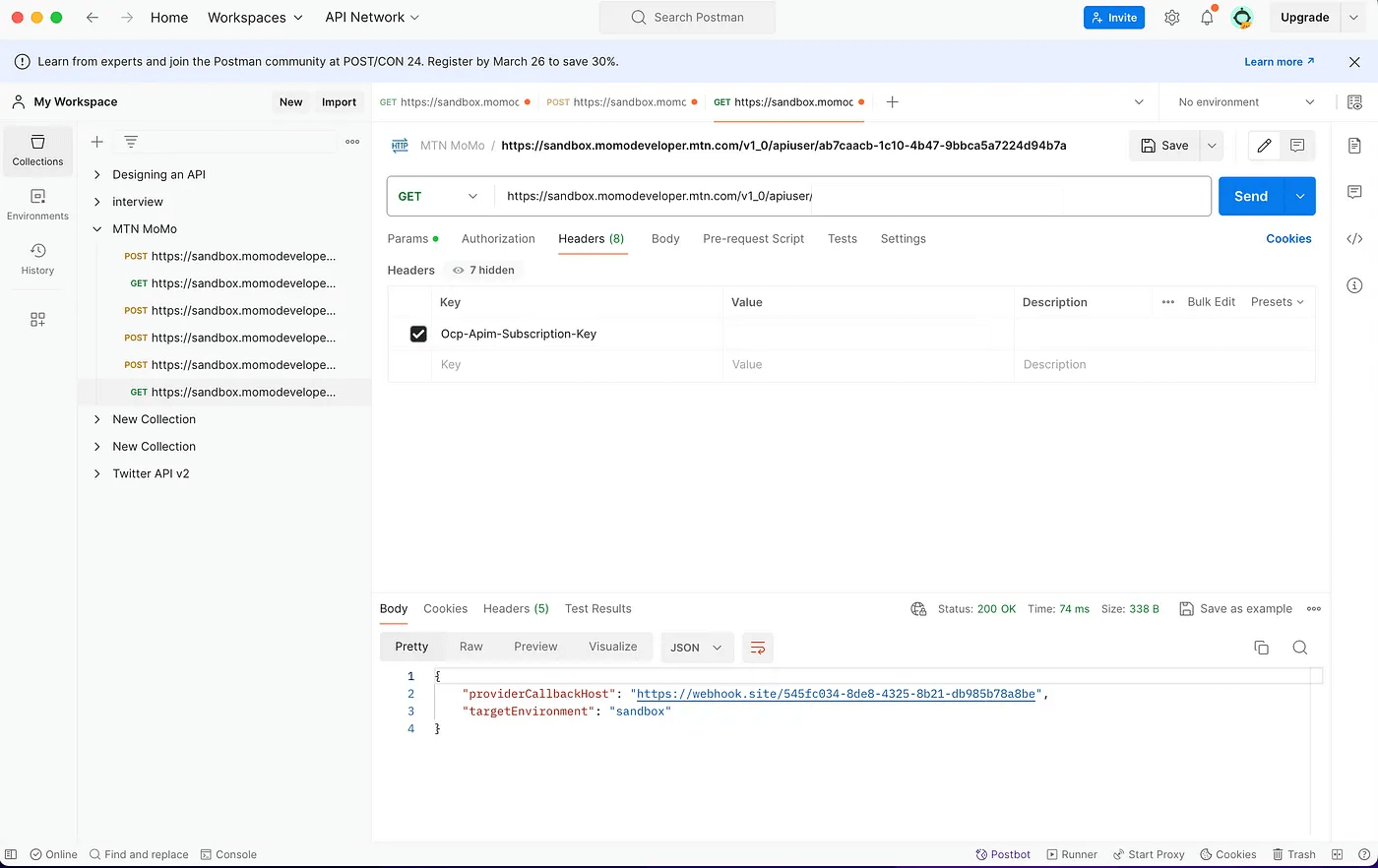
Visual representation of the response body from the “get user information” request.
Once you’ve created a new user and retrieved their information, it’s time to delve deeper into the collection’s product features. WELL they require an API key and bearer token for each API request to get started. These essential elements act as access passes, allowing the API to recognize the source of the request and grant us access to the necessary resources.
To get started, we’ll generate an API key by making a POST request to the URL https://sandbox.momodeveloper.mtn.com/v1_0/apiuser/{X-Reference-Key}/apikey, replacing “X-Reference-Key” with the UUID. Remember to include your subscription key in the request headers.
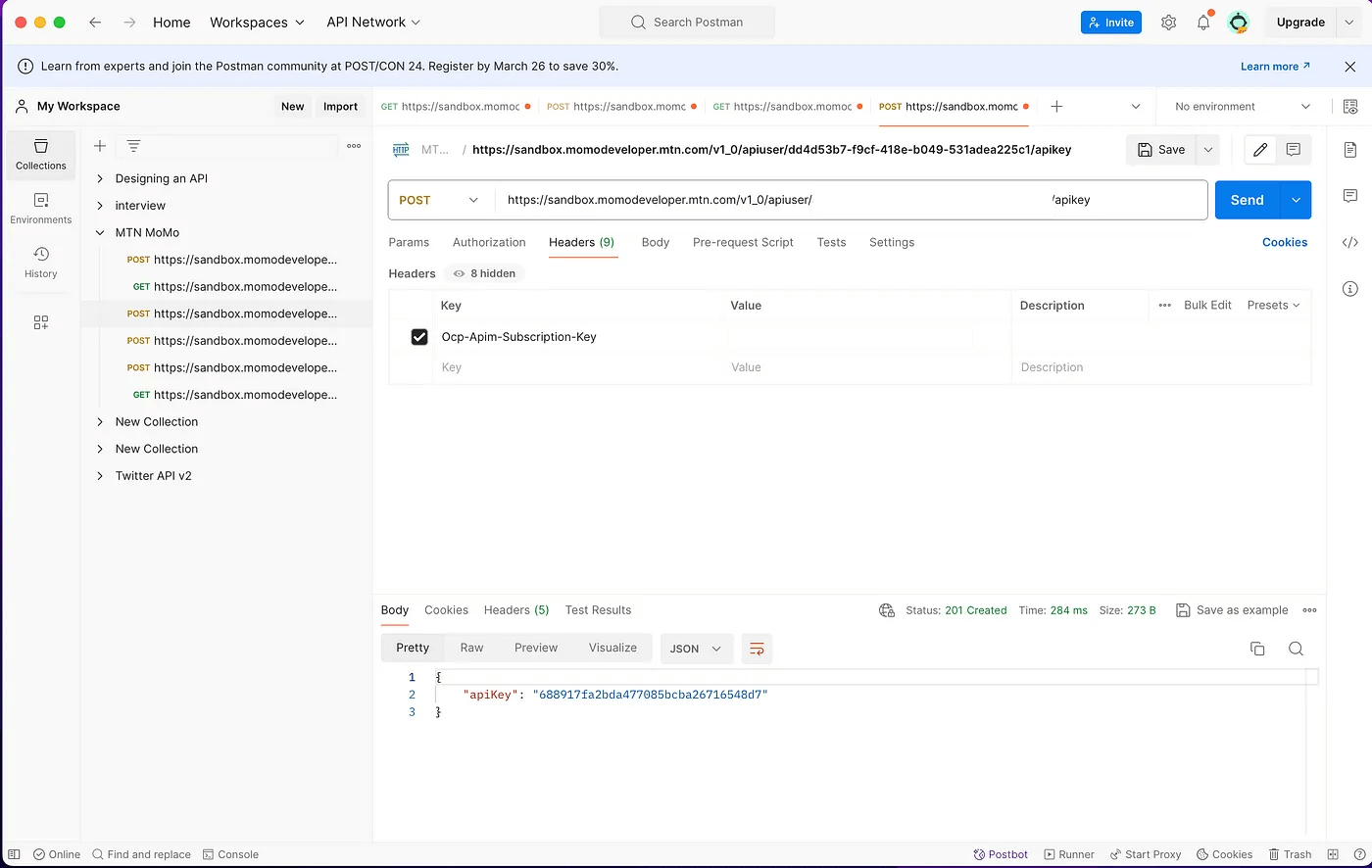
Visual representation of the API key received in the response.
Next, we will create a bearer token to authenticate each request to the various endpoints of the collection product. For this step, we’ll approach things a little differently. We will initiate a POST request to the URL https://sandbox.momodeveloper.mtn.com/collection/token/, including the subscription key in the headers. Using basic authentication, we will set the username as X-Reference-Id and the recently generated API key as the password.

Visual representation of the bearer token returned by the POST request.
We can now use the collection product endpoints, specifically the “payment request” endpoint, although with the information provided we can also use all other endpoints. We start by sending a POST request to the URL https://sandbox.momodeveloper.mtn.com/collection/v1_0/requesttopay. This request operates in three distinct states:
1. Approval status: where the consumer provides their PIN, confirming the transaction and marking it as successful.
2. Status pending: where the request awaits approval or rejection by the consumer.
3. State of refusal: where the consumer refuses the request.
In the request headers, next to the standard X-Reference-Id and subscription key, we will introduce the recovered target environment when recovering user information. Additionally, we will update the authorization method for bearer token authentication using the newly acquired bearer token. We will include a JSON object with the specified properties in the request body. Feel free to customize the values as needed.
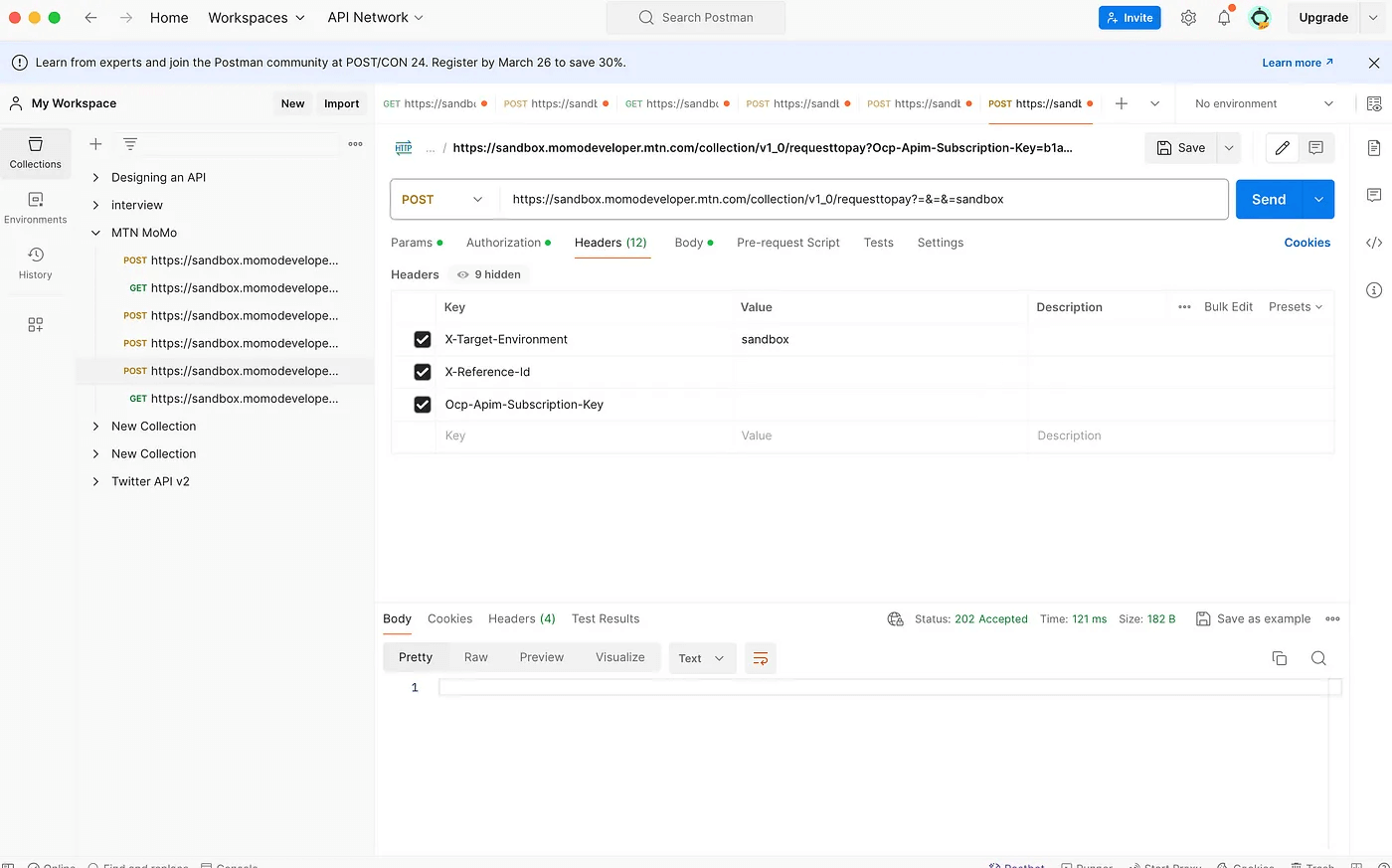
Visual representation of a successful “request for payment” request.
Before concluding, let’s briefly explain the properties within the JSON object sent as the body of the “payment request” request:
The “amount” indicates the money debited from the consumer’s account, while the “currency” indicates the name of the currency of the transaction. The “External ID” serves as a reference for the transaction, aiding in reconciliation and reporting of transaction history. Inside the nested “payer” object, “partyIdType” can be “MSISDN” for a validated phone number or “EMAIL” for a verified email address. The “partyId” represents the consumer’s phone number. The “payerMessage” field contains the message for the payer’s transaction history, and finally, “payeeNote” includes a note for the payee’s transaction history. Customize these properties as needed for your transactions.
In the dynamic world of digital finance, the MTN MoMo Open API stands out as a game changer for those ready to redefine financial services.
Despite the potential of the MTN Mobile Money platform and its API, we have identified technical barriers that need to be addressed, from complex documentation to improved functionality. It is up to us, the technology community, to advance these improvements and shape the future of FinTech through open source collaboration.
Read Andela’s latest guide to hiring the best FinTech engineers apply technological advances to improve current and create new financial products and services.
YOUTUBE.COM/THENEWSTACK
Technology moves fast, don’t miss an episode. Subscribe to our YouTube channel to stream all our podcasts, interviews, demos and more.
SUBSCRIBE
Group created with Sketch.

Zziwa Raymond is a full-stack engineer and member of the Andela Talent Network, a private global marketplace for digital talent. Specializing in Next.js, React, JavaScript, TypeScript, NestJs and others, he has developed a deep holistic understanding of both the frontend…
Read more from Zziwa Raymond
Fintech
US Agencies Request Information on Bank-Fintech Dealings

Federal banking regulators have issued a statement reminding banks of the potential risks associated with third-party arrangements to provide bank deposit products and services.
The agencies support responsible innovation and banks that engage in these arrangements in a safe and fair manner and in compliance with applicable law. While these arrangements may offer benefits, supervisory experience has identified a number of safety and soundness, compliance, and consumer concerns with the management of these arrangements. The statement details potential risks and provides examples of effective risk management practices for these arrangements. Additionally, the statement reminds banks of existing legal requirements, guidance, and related resources and provides insights that the agencies have gained through their oversight. The statement does not establish new supervisory expectations.
Separately, the agencies requested additional information on a broad range of arrangements between banks and fintechs, including for deposit, payment, and lending products and services. The agencies are seeking input on the nature and implications of arrangements between banks and fintechs and effective risk management practices.
The agencies are considering whether to take additional steps to ensure that banks effectively manage the risks associated with these different types of arrangements.
SUBSCRIBE TO THE NEWSLETTER
And get exclusive articles on the stock markets
Fintech
What changes in financial regulation have impacted the development of financial technology?

Exploring the complex landscape of global financial regulation, we gather insights from leading fintech leaders, including CEOs and finance experts. From the game-changing impact of PSD2 to the significant role of GDPR in data security, explore the four key regulatory changes that have reshaped fintech development, answering the question: “What changes in financial regulation have impacted fintech development?”
- PSD2 revolutionizes access to financial technology
- GDPR Improves Fintech Data Privacy
- Regulatory Sandboxes Drive Fintech Innovation
- GDPR Impacts Fintech Data Security
PSD2 revolutionizes access to financial technology
When it comes to regulatory impact on fintech development, nothing comes close to PSD2. This EU regulation has created a new level playing field for market players of all sizes, from fintech startups to established banks. It has had a ripple effect on other markets around the world, inspiring similar regulatory frameworks and driving global innovation in fintech.
The Payment Services Directive (PSD2), the EU law in force since 2018, has revolutionized the fintech industry by requiring banks to provide third-party payment providers (TPPs) with access to payment services and customer account information via open APIs. This has democratized access to financial data, fostering the development of personalized financial instruments and seamless payment solutions. Advanced security measures such as Strong Customer Authentication (SCA) have increased consumer trust, pushing both fintech companies and traditional banks to innovate and collaborate more effectively, resulting in a dynamic and consumer-friendly financial ecosystem.
The impact of PSD2 has extended beyond the EU, inspiring similar regulations around the world. Countries such as the UK, Australia and Canada have launched their own open banking initiatives, spurred by the benefits seen in the EU. PSD2 has highlighted the benefits of open banking, also prompting US financial institutions and fintech companies to explore similar initiatives voluntarily.
This has led to a global wave of fintech innovation, with financial institutions and fintech companies offering more integrated, personalized and secure services. The EU’s leadership in open banking through PSD2 has set a global standard, promoting regulatory harmonization and fostering an interconnected and innovative global financial ecosystem.
Looking ahead, the EU’s PSD3 proposals and Financial Data Access (FIDA) regulations promise to further advance open banking. PSD3 aims to refine and build on PSD2, with a focus on improving transaction security, fraud prevention, and integration between banks and TPPs. FIDA will expand data sharing beyond payment accounts to include areas such as insurance and investments, paving the way for more comprehensive financial products and services.
These developments are set to further enhance connectivity, efficiency and innovation in financial services, cementing open banking as a key component of the global financial infrastructure.
General Manager, Technology and Product Consultant Fintech, Insurtech, Miquido
GDPR Improves Fintech Data Privacy
Privacy and data protection have been taken to another level by the General Data Protection Regulation (GDPR), forcing fintech companies to tighten their data management. In compliance with the GDPR, organizations must ensure that personal data is processed fairly, transparently, and securely.
This has led to increased innovation in fintech towards technologies such as encryption and anonymization for data protection. GDPR was described as a top priority in the data protection strategies of 92% of US-based companies surveyed by PwC.
Financial Expert, Sterlinx Global
Regulatory Sandboxes Drive Fintech Innovation
Since the UK’s Financial Conduct Authority (FCA) pioneered sandbox regulatory frameworks in 2016 to enable fintech startups to explore new products and services, similar frameworks have been introduced in other countries.
This has reduced the “crippling effect on innovation” caused by a “one size fits all” regulatory approach, which would also require machines to be built to complete regulatory compliance before any testing. Successful applications within sandboxes give regulators the confidence to move forward and address gaps in laws, regulations, or supervisory approaches. This has led to widespread adoption of new technologies and business models and helped channel private sector dynamism, while keeping consumers protected and imposing appropriate regulatory requirements.
Co-founder, UK Linkology
GDPR Impacts Fintech Data Security
A big change in financial regulations that has had a real impact on fintech is the 2018 EU General Data Protection Regulation (GDPR). I have seen how GDPR has pushed us to focus more on user privacy and data security.
GDPR means we have to handle personal data much more carefully. At Leverage, we have had to step up our game to meet these new rules. We have improved our data encryption and started doing regular security audits. It was a little tricky at first, but it has made our systems much more secure.
For example, we’ve added features that give users more control over their data, like simple consent tools and clear privacy notices. These changes have helped us comply with GDPR and made our customers feel more confident in how we handle their information.
I believe that GDPR has made fintech companies, including us at Leverage, more transparent and secure. It has helped build trust with our users, showing them that we take data protection seriously.
CEO & Co-Founder, Leverage Planning
Related Articles
Fintech
M2P Fintech About to Raise $80M

Application Programming Interface (API) Infrastructure Platform M2P Financial Technology has reached the final round to raise $80 million, at a valuation of $900 million.
Specifically, M2P Fintech, formerly known as Yap, is closing a new funding round involving new and existing investors, according to entrackr.com. The India-based company, which last raised funding two and a half years ago, previously secured $56 million in a round led by Insight Partners, earning a post-money valuation of $650 million.
A source indicated that M2P Fintech is ready to raise $80 million in this new funding round, led by a new investor. Existing backers, including Insight Partners, are also expected to participate. The new funding is expected to go toward enhancing the company’s technology infrastructure and driving growth in domestic and international markets.
What does M2P Fintech do?
M2P Fintech’s API platform enables businesses to provide branded financial services through partnerships with fintech companies while maintaining regulatory compliance. In addition to its operations in India, the company is active in Nepal, UAE, Australia, New Zealand, Philippines, Bahrain, Egypt, and many other countries.
Another source revealed that M2P Fintech’s valuation in this funding round is expected to be between USD 880 million and USD 900 million (post-money). The company has reportedly received a term sheet and the deal is expected to be publicly announced soon. The Tiger Global-backed company has acquired six companies to date, including Goals101, Syntizen, and BSG ITSOFT, to enhance its service offerings.
According to TheKredible, Beenext is the company’s largest shareholder with over 13% ownership, while the co-founders collectively own 34% of the company. Although M2P Fintech has yet to release its FY24 financials, it has reported a significant increase in operating revenue. However, this growth has also been accompanied by a substantial increase in losses.
Fintech
Scottish financial technology firm Aveni secures £11m to expand AI offering
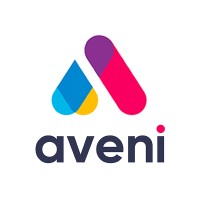
By Gloria Methri
Today
- To come
- Aveni Assistance
- Aveni Detection
Artificial intelligence Financial Technology Aveni has announced one of the largest Series A investments in a Scottish company this year, amounting to £11 million. The investment is led by Puma Private Equity with participation from Par Equity, Lloyds Banking Group and Nationwide.
Aveni combines AI expertise with extensive financial services experience to create large language models (LLMs) and AI products designed specifically for the financial services industry. It is trusted by some of the UK’s leading financial services firms. It has seen significant business growth over the past two years through its conformity and productivity solutions, Aveni Detect and Aveni Assist.
This investment will enable Aveni to build on the success of its existing products, further consolidate its presence in the sector and introduce advanced technologies through FinLLM, a large-scale language model specifically for financial services.
FinLLM is being developed in partnership with new investors Lloyds Banking Group and Nationwide. It is a large, industry-aligned language model that aims to set the standard for transparent, responsible and ethical adoption of generative AI in UK financial services.
Following the investment, the team developing the FinLLM will be based at the Edinburgh Futures Institute, in a state-of-the-art facility.
Joseph Twigg, CEO of Aveniexplained, “The financial services industry doesn’t need AI models that can quote Shakespeare; it needs AI models that deliver transparency, trust, and most importantly, fairness. The way to achieve this is to develop small, highly tuned language models, trained on financial services data, and reviewed by financial services experts for specific financial services use cases. Generative AI is the most significant technological evolution of our generation, and we are in the early stages of adoption. This represents a significant opportunity for Aveni and our partners. The goal with FinLLM is to set a new standard for the controlled, responsible, and ethical adoption of generative AI, outperforming all other generic models in our select financial services use cases.”
Previous Article
Network International and Biz2X Sign Partnership for SME Financing
IBSi Daily News Analysis

SMBs Leverage Cloud to Gain Competitive Advantage, Study Shows
IBSi FinTech Magazine
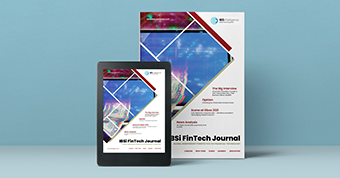
- The Most Trusted FinTech Magazine Since 1991
- Digital monthly issue
- Over 60 pages of research, analysis, interviews, opinions and rankings
- Global coverage
subscribe now
-

 DeFi11 months ago
DeFi11 months agoDeFi Technologies Appoints Andrew Forson to Board of Directors
-

 Fintech11 months ago
Fintech11 months agoUS Agencies Request Information on Bank-Fintech Dealings
-

 News12 months ago
News12 months agoBlock Investors Need More to Assess Crypto Unit’s Earnings Potential, Analysts Say — TradingView News
-

 DeFi11 months ago
DeFi11 months agoSwitchboard Revolutionizes DeFi with New Oracle Aggregator
-

 DeFi11 months ago
DeFi11 months agoIs Zypto Wallet a Reliable Choice for DeFi Users?
-

 News12 months ago
News12 months agoBitcoin and Technology Correlation Collapses Due to Excess Supply
-

 Fintech11 months ago
Fintech11 months agoWhat changes in financial regulation have impacted the development of financial technology?
-

 Fintech11 months ago
Fintech11 months agoScottish financial technology firm Aveni secures £11m to expand AI offering
-
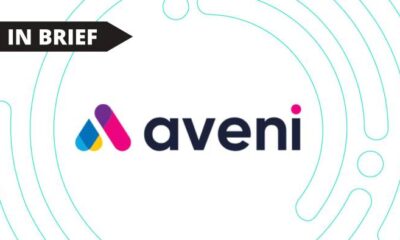
 Fintech11 months ago
Fintech11 months agoScottish financial technology firm Aveni raises £11m to develop custom AI model for financial services
-

 News1 year ago
News1 year agoValueZone launches new tools to maximize earnings during the ongoing crypto summer
-

 Videos5 months ago
Videos5 months ago“Artificial intelligence is bringing us to a future that we may not survive” – Sco to Whitney Webb’s Waorting!
-

 DeFi1 year ago
DeFi1 year agoTON Network Surpasses $200M TVL, Boosted by Open League and DeFi Growth ⋆ ZyCrypto






